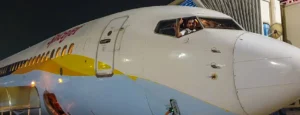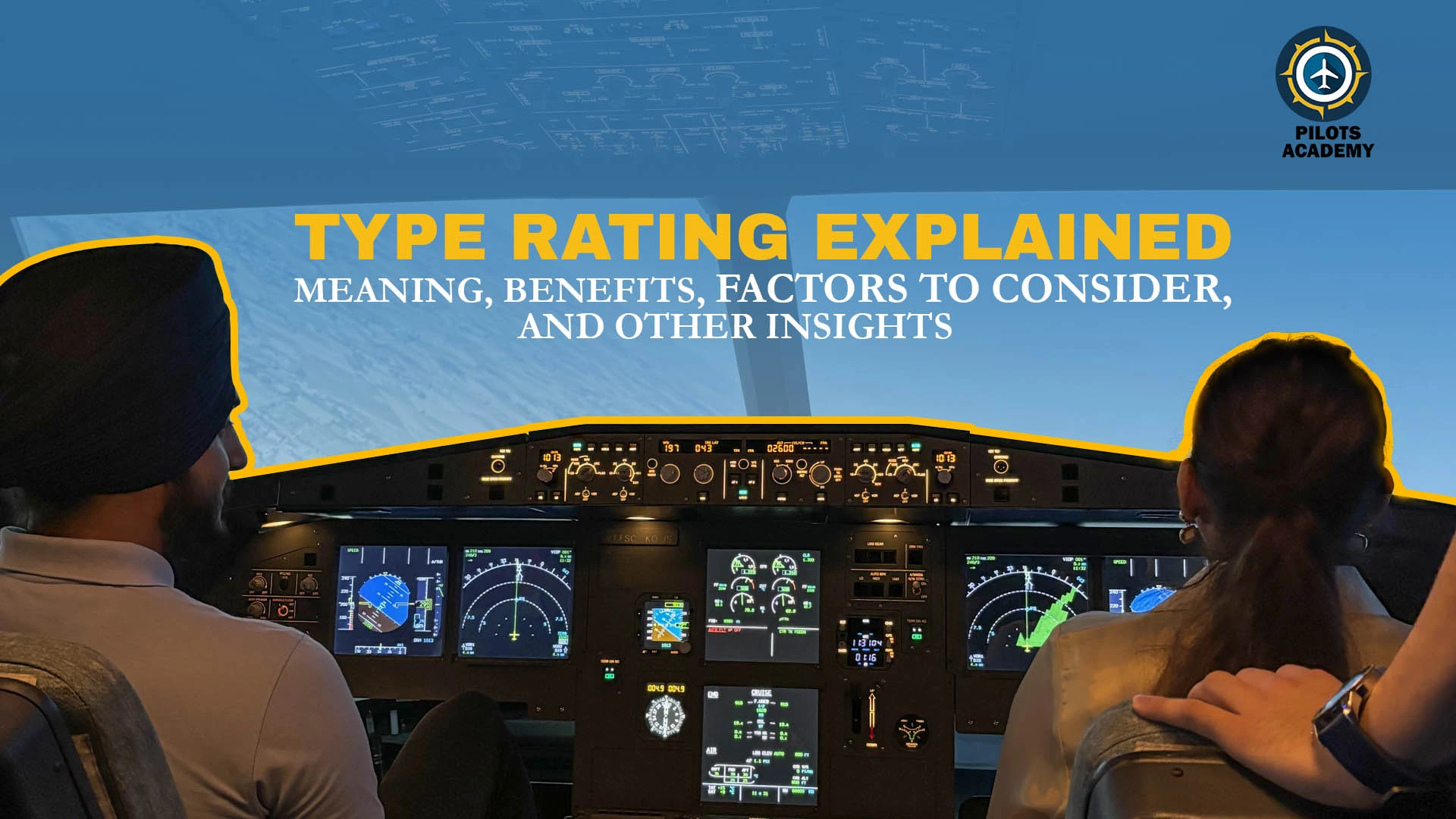If you have aced your Commercial Pilot License (CPL) and are ready to soar into the professional skies, there’s one crucial certification standing between you and the captain’s seat: Type Rating. If you’re new to the term, don’t worry, we’ve got you covered. In this blog, we’ll dive into what it is, the importance of type rating for commercial pilots, break down the steps involved, and guide you in selecting the ideal course that aligns with your career aspirations. By the end, you’ll have the clarity to take the next big step in your flying career.

What is Type Rating in Aviation?
Type Rating or TR is an advanced certification that allows pilots to operate a specific type of aircraft. While your CPL teaches you the fundamentals of flying, it’s the TR that specialises you in handling the complexities of particular aircraft, such as a Boeing 737 or Airbus A320. With a Type Rating endorsement, you will be eligible to fly an aircraft with an All Up Weight (AUW) over 5700 Kgs and have multi-crew training.
Benefits of Type Rating Training
The aviation industry categorises planes based on their systems, size, and operation techniques. Since each aircraft has unique systems and requirements, regulatory authorities like the FAA, EASA, or DGCA mandate Type Rating for safety and standardisation. Some of the reasons why getting Type Rated is important are as follows:
1. Operational Expertise
Modern aircraft come with advanced avionics, automated systems, and unique operational methods that require specialised training.
2. Regulatory Compliance
Airlines and aviation authorities worldwide won’t let you near the cockpit of a commercial jet without this certification.
3. Airline Hiring Preferences For Type-Rated Pilots
Airlines prioritise hiring pilots with TR, making it an essential qualification for landing your dream job.
4. Safety Standards
TR training emphasises safety, teaching pilots to handle emergencies, navigate technical systems, and maintain precision in high-stress scenarios.
Steps Involved in a Type Rating Certification Process
1. Meeting Type Rating Eligibility Requirements
Before pursuing a TR, you must check whether you are eligible for the program. The criteria might slightly vary depending on which country’s TR endorsement you will pursue, the pilot institute, and the chosen aircraft (for instance, it is not necessary to have a minimum of 25 hours of multi-engine aircraft experience as per Boeing 737 type rating requirements, whereas Airbus A320 does). However, these are the general requirements you must meet:
-
- Hold a valid Commercial Pilot License (CPL) or Airline Transport Pilot License (ATPL)
- Certificate of 70 pilot-in-command (PIC) hours
- Valid ME/IR (Multi-Engine and Instrument Rating)
- Valid Class 1 Medical Certificate
- English level 4 ICAO or more
2. Ground School Training
This phase involves learning the technical systems, performance, and operations of the chosen aircraft. Expect to dive deep into avionics, fuel systems, engine management, and much more in a classroom setting.
3. Simulator Training
A crucial part of TR, simulator training allows you to practice flying the aircraft in a realistic, risk-free environment. You’ll handle various scenarios, including emergencies, take-offs, and landings. This is where your skills are put to the test under the guidance of certified instructors.
4. Check Ride and Certification
The final step is the check ride. It involves a practical exam conducted by a certified examiner. Upon successful completion, you’ll earn your TR endorsement, qualifying you to operate the specific aircraft.
How to Choose the Right Type Rating Course
Choosing the right Type Rating course is just as important as earning your CPL. Here are the factors you need to consider:
1. Aircraft Preference and Career Goals
-
- Identify Your Goals: Do you want to fly short-haul routes on an Airbus A320 or operate long-haul flights on a Boeing 737? Your career aspirations should guide your choice of aircraft.
- Industry Demand: Research the demand for pilots trained on specific aircraft. Opting for a popular model can increase your employability.
- Region and Airlines Survey: Research airlines in your preferred region to see which aircraft dominate their fleet.
2. Reputation of the Training Institute
Not all Type Rating institutes are created equal. Look for schools that have:
-
- A strong track record of successful placements.
- Relevant and approved aviation authorises (such as EASA, DGCA, or FAA).
- Read reviews and testimonials from alumni to assess the quality of training.
3. Simulator Facilities

Advanced simulator facilities are a must for effective training. Ensure the institute uses certified, state-of-the-art simulators for your chosen aircraft type. Ask about the number of simulator hours included in the course, as hands-on practice is essential for mastering aircraft systems.
4. Experienced Instructors
The quality of your instructors can make or break your training experience. Look for academies that not only employ seasoned pilots with real-world flying experience on the aircraft you’re training for but are also passionate about teaching.
5. Type Rating Cost and Financial Options
TR can be a significant investment, so it’s important to choose a program that offers value for money. Compare the cost of type rating in India and abroad across academies and check for hidden fees. Many institutes offer flexible payment plans and financing options to ease the financial burden.
6. Location and Accessibility
Consider the geographic location of the training center. Does the program offer housing or visa support if it’s abroad? Proximity to airline hubs can also be advantageous for networking opportunities.
7. Networking Opportunities and Job Assistance
A reputable training institute connects you with industry professionals, recruiters, and fellow pilots. Networking during your Type Rating program can open doors to job opportunities.
Advantages of Choosing the Right TR Course
When you pick the right TR program, you’re not just earning an endorsement, you’re laying the foundation for a successful aviation career. The right program ensures:
- Enhanced Confidence: You’ll master the intricacies of your chosen aircraft, boosting your confidence.
- Increased Employability: Airlines are more likely to hire pilots with high-quality training from reputed institutes.
- Professional Networking: Building connections with instructors, peers, and industry leaders can help you land your dream job.
Why Choose Pilots Academy for Your Type Rating?

We understand that your journey to the cockpit is both exciting and challenging. That’s why our TR programs are designed to provide comprehensive training tailored to your career aspirations. Here’s what sets us apart:
- Popular Aircraft Options: From Type Rating for Airbus A320, and Boeing 737, to ATR aircraft, we offer TR programs for a popular range of aircraft to align with your career goals.
- World-Class Simulators: Our training centers are equipped with state-of-the-art simulators to ensure hands-on learning in realistic scenarios.
- Expert Instructors: Learn from experienced aviation professionals who bring real-world insights to the classroom.
- Global Partnerships: We collaborate with airlines and aviation training centers worldwide to offer you unmatched opportunities. At present, we have tie-ups in India, Sharjah, South Africa, Columbia, Madrid, Jakarta, and Germany to offer our students TR opportunities at an international level.
- Flexible Financing: We offer payment plans that make high-quality training accessible without financial strain.
- Amenities and Facilities: Our TR packages are all-inclusive where you get tickets, Visa help, accommodation, fully-equipped gyms, and much more.
- Proven Placement Record: Our graduates are sought after by top airlines worldwide, thanks to our strong industry connections and reputation. We have a strong alumni base working in the top national and international airlines.
To Wrap Up
Type Rating is your gateway to unlocking your aviation potential and advancing your career as a commercial pilot. By choosing the right course, you’re equipping yourself with the skills and confidence to succeed in a competitive industry. Choosing the right course is a critical decision that requires careful consideration of your goals, the training institute’s reputation, and the resources they offer.
If you’re ready to take this crucial step in your aviation journey, let us be your co-pilot. Explore our TR programs today and let’s get you one step closer to the cockpit of your dreams.
FAQs
1. How long is a Type Rating course duration?
The duration varies depending on the aircraft type and the training institute. Typically, a Type Rating course takes 6-8 weeks, including ground school, simulator training, and base training.
Can I become a pilot without a Type Rating?
Yes, you can become a licensed pilot without a Type Rating. Earning your Commercial Pilot License (CPL) qualifies you to fly smaller aircraft used in general aviation
3. How much does a Type Rating course cost?
Costs depend on the aircraft type, training location, and institute. On average, a Type Rating course can range between Rs.15 Lakhs and Rs.30 Lakhs. Pilots Academy offers TR at the lowest cost in the market to make this investment manageable. Contact our team to find out!
4. Can I hold multiple Type Rating endorsements?
Yes, you can hold multiple Type Rating endorsements for different aircraft. However, only the most recently issued endorsement will be considered valid and active for operational purposes.
5. Can I do my Type Rating in a country different from where I earned my CPL?
Absolutely! Many pilots choose to do their Type Rating abroad.


